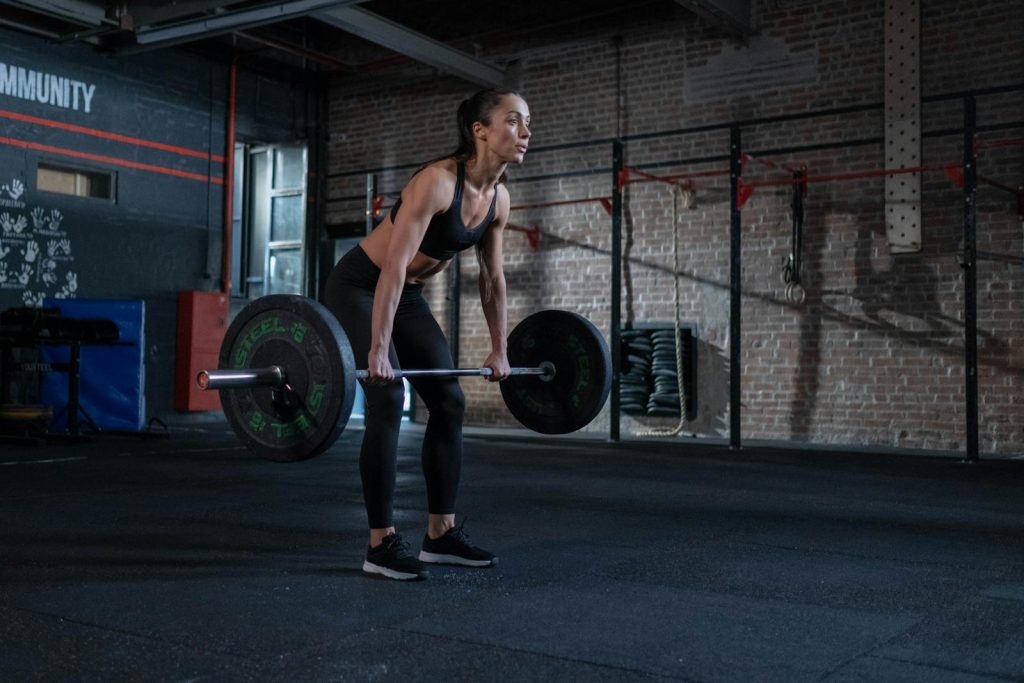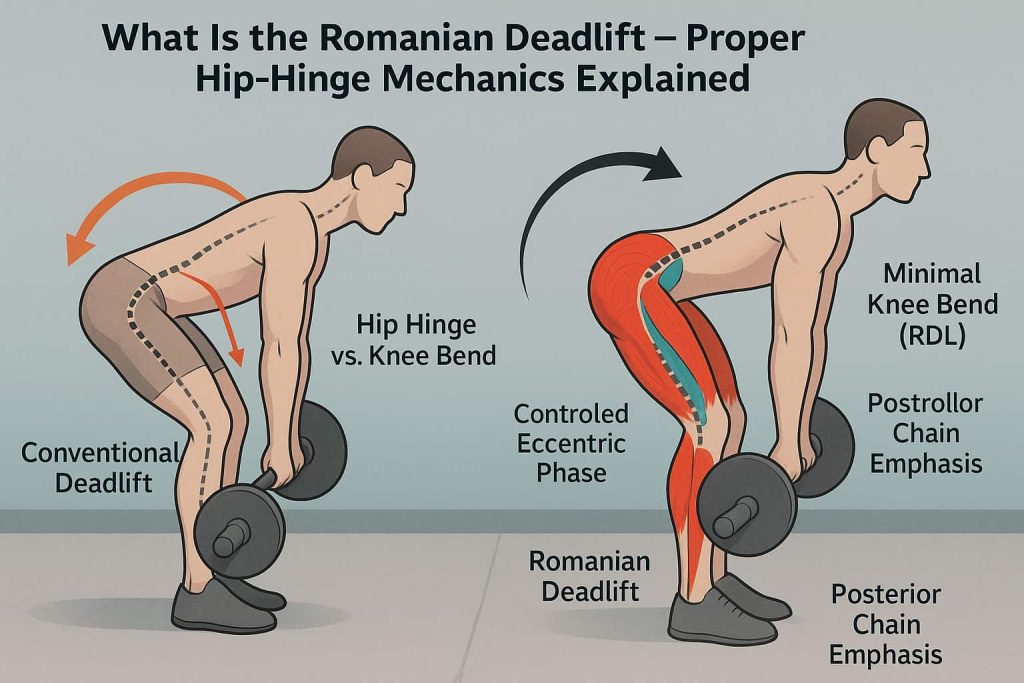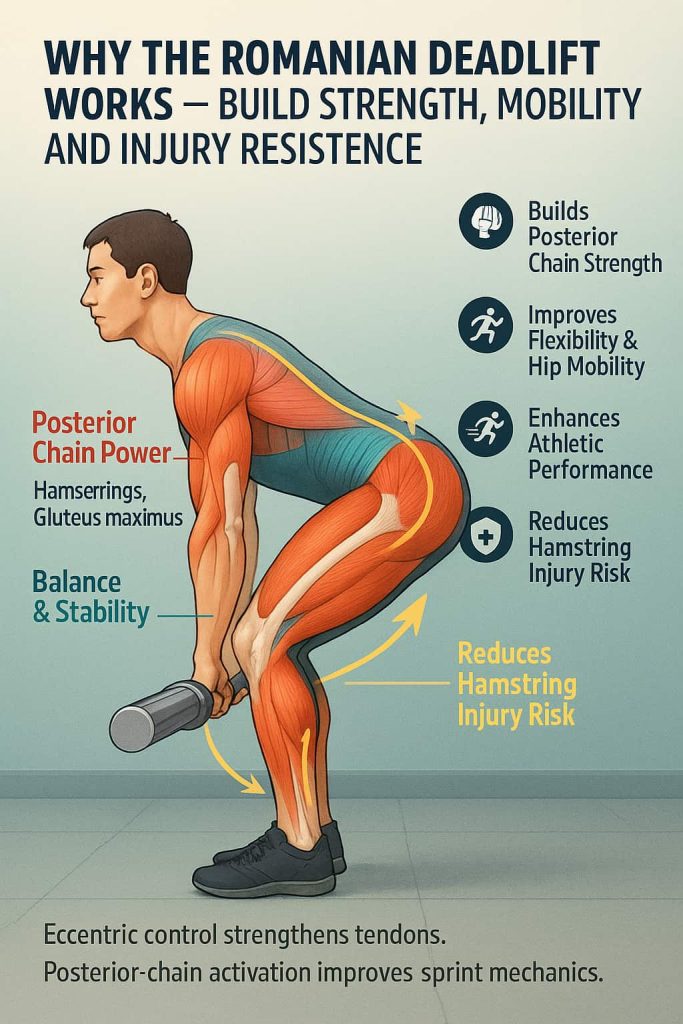The Romanian Deadlift (RDL) is one of the most effective exercises to strengthen your hamstrings, glutes, and improve posture—all through a perfect hip hinge.
Unlike the traditional deadlift, the RDL focuses on slow, controlled lowering, training your muscles in a lengthened position to build strength, mobility, and resilience.

Understanding the RDL is key to unlocking your full posterior-chain power. This guide will explain how to perform it correctly, its proven benefits, muscle activation insights from recent studies, and safety tips for every fitness level.
What Is the Romanian Deadlift?
The Romanian Deadlift is a hip-dominant strength exercise that targets the hamstrings and glutes through a controlled eccentric movement (lowering phase). The lift begins from a standing position rather than the floor, emphasizing hip hinging instead of knee bending.

Key difference:
- The Conventional Deadlift uses more knee flexion and quadriceps drive.
- The Romanian Deadlift keeps the knees slightly bent, loading the hamstrings under stretch.
Biomechanical and EMG research shows RDLs emphasize the posterior chain with a controlled hip-hinge and reduced knee flexion compared with conventional deadlifts; posterior-chain–focused training is also associated with improved low-back outcomes in resistance programs.
How to Do the Romanian Deadlift
Step-by-Step Technique
- Start Position
- Stand tall with feet hip-width apart, barbell or dumbbells held in front of thighs.
- Keep a soft bend in the knees.
- Hinge from the Hips
- Push your hips back while maintaining a neutral spine.
- The bar should travel close to your legs as you lower.
- Lower to Mid-Shin
- Lower the weight until you feel a strong stretch in your hamstrings—typically mid-shin.
- Keep your shoulders above your hips and your back flat.
- Drive Up
- Press your feet into the floor and extend your hips to return to standing.
- Squeeze your glutes at the top, but do not hyperextend your spine.
Breathing Tip
- Inhale as you lower the bar.
- Exhale while driving back up.
Trainer Tip
Focus on hip movement, not knee bend.
Imagine “closing a car door with your hips.” Keep your spine neutral and bar close to your body at all times.
Start light until your form is flawless—mastery beats heavy weight every time.
Why the Romanian Deadlift Works
1. Builds Posterior Chain Strength
The RDL targets the hamstrings, gluteus maximus, and spinal erectors, key muscles for hip extension and posture control.
2. Improves Flexibility and Mobility
By training under a deep stretch, the RDL enhances hamstring flexibility and hip mobility, making it ideal for athletes and people with tight posterior chains.

3. Enhances Athletic Performance
Strong hip extensors translate to faster sprinting, higher jumping, and better balance. Research published in Journal of Strength & Conditioning Research (2024) found that RDL training improves sprint acceleration and horizontal force output.
4. Supports Injury Prevention
A 2025 cohort study found that incorporating single-leg RDLs (SLRDLs) into warm-ups significantly reduced mild-to-moderate hamstring strain injuries among athletes. The eccentric control of RDLs strengthens tendons and reduces the risk of re-injury.
Muscles Worked
| Primary Muscles | Secondary Muscles | Stabilizers |
|---|---|---|
| Hamstrings (semitendinosus, biceps femoris, semimembranosus) | Gluteus maximus, adductor magnus | Erector spinae, lats, trapezius, forearms, core |
Why it matters:
These muscles collectively form your posterior chain, responsible for maintaining posture, generating power, and supporting your spine during daily movement.
Variations & Alternatives
1. Dumbbell Romanian Deadlift (DB RDL)
Why it works:
Using dumbbells allows for a greater range of motion and balanced unilateral engagement. Each arm works independently, improving coordination and correcting muscle imbalances between sides.
Muscles worked:
Hamstrings, gluteus maximus, erector spinae, core stabilizers, and forearms (grip strength).
How to do it:
- Hold a dumbbell in each hand with palms facing your thighs.
- Keep feet hip-width apart and knees slightly bent.
- Hinge at the hips, sliding the dumbbells down along your legs until you feel a deep hamstring stretch.
- Keep your spine neutral and shoulders pulled back.
- Drive hips forward to return to standing.
Trainer Tip:
Maintain control throughout the movement—avoid bouncing or locking out your knees. Ideal for beginners or home workouts without barbells.
2. Single-Leg Romanian Deadlift (SLRDL)
Why it works:
This unilateral variation challenges balance, hip stability, and proprioception, activating stabilizing muscles in your glutes and core. It’s also a proven exercise for reducing hamstring strain risk in athletes.
Muscles worked:
Hamstrings, gluteus medius and maximus, erector spinae, and deep core stabilizers.
How to do it:
- Stand tall holding a dumbbell in one hand (same side as working leg).
- Hinge forward on one leg, keeping the non-working leg extended straight behind you.
- Lower the dumbbell to mid-shin height while keeping hips square and back straight.
- Engage the glutes and hamstrings to return to the starting position.
Trainer Tip:
Focus on pelvic alignment—don’t let your hips rotate outward. Perform barefoot or on a balance pad for added proprioceptive challenge. Start with bodyweight if balance is limited.
3. Paused Romanian Deadlift
Why it works:
Adding a pause at the bottom (1–2 seconds) increases time under tension and reinforces control at the most stretched point, improving eccentric strength and hamstring stability.
Muscles worked:
Hamstrings, glutes, spinal erectors, and core stabilizers.
How to do it:
- Perform a standard RDL.
- Once the bar reaches mid-shin, pause for 1–2 seconds without resting the weight.
- Focus on maintaining tension through your hamstrings and glutes.
- Drive hips forward to stand tall.
Trainer Tip:
Use lighter weights than your regular RDL load—control and tension are the goals here. Excellent for improving deadlift technique and posterior-chain awareness.
4. Tempo Romanian Deadlift
Why it works:
Slowing down the eccentric phase (3–4 seconds) maximizes muscle fiber recruitment and strengthens the hamstrings through a longer time under tension—perfect for hypertrophy or rehab settings.
Muscles worked:
Hamstrings, glutes, erector spinae, and lower back stabilizers.
How to do it:
- Lower the barbell slowly over 3–4 seconds until you reach mid-shin level.
- Pause briefly, then rise in 1 second to starting position.
- Maintain a steady breathing rhythm (inhale down, exhale up).
Trainer Tip:
Time your descent with a count—“1-2-3-down”—to keep consistency. If you lose form before finishing your count, stop and reset your hinge mechanics.
5. Deficit Romanian Deadlift
Why it works:
Standing on a raised platform (2–4 inches) increases the range of motion, demanding deeper hamstring and glute stretch. This builds flexibility and end-range strength—beneficial for advanced athletes.
Muscles worked:
Hamstrings (especially semitendinosus), gluteus maximus, erector spinae, and core stabilizers.
How to do it:
- Stand on a low platform with feet hip-width apart.
- Perform a slow RDL, lowering the barbell slightly below your standard range.
- Keep the bar close to your legs and spine neutral.
- Drive hips forward to return to standing.
Trainer Tip:
Use moderate loads—don’t chase depth at the expense of form. This variation is advanced; perfect your standard RDL first.
Safety & Precautions
- Keep a neutral spine throughout the lift—avoid rounding your back.
- Maintain soft knees; do not lock out or hyperextend.
- Always warm up your hips and hamstrings with dynamic stretches or bodyweight RDLs.
- Beginners should start with dumbbells or PVC pipe before progressing to a barbell.
- Consult a certified trainer or physical therapist if you experience pain or tightness.
Common Mistakes to Avoid
- Rounding the back: Increases lower-back strain.
- Excessive knee bend: Turns the lift into a squat pattern.
- Bar too far from legs: Shifts load to lower back instead of hamstrings.
- Jerking the weight: Avoid bouncing at the bottom; control the eccentric phase.
Programming Tips
- Frequency: 2–3 times per week.
- Reps & Sets: 3–5 sets of 6–12 reps depending on goal (strength vs hypertrophy).
- Tempo: 3-second lowering (eccentric), 1-second lift.
- Rest: 60–90 seconds for hypertrophy, 2–3 minutes for strength.
Pair With:
- Hip Thrusts
- Glute Bridges
- Nordic Curls
- Back Extensions
These complementary moves reinforce the same hip-extension mechanics and enhance posterior chain performance.
FAQ
1. Is the Romanian Deadlift safe for beginners?
Yes, it’s safer than a conventional deadlift when learned correctly. Start light and focus on the hip hinge pattern first.
2. What’s the difference between RDL and stiff-leg deadlift?
The stiff-leg deadlift keeps legs nearly locked, placing more strain on the lower back. RDL maintains slight knee bend for better hamstring focus.
3. How far should I lower the bar?
Stop when you feel a deep hamstring stretch without losing your back’s neutral position—usually mid-shin level.
4. Can I do RDLs with dumbbells?
Absolutely. Dumbbells allow better shoulder mobility and control for beginners or unilateral training.
5. How does RDL prevent injuries?
Eccentric control strengthens the hamstring tendons, reducing risk of strains—especially in athletes.
6. Is RDL good for posture?
Yes. It strengthens posterior-chain muscles that counteract forward rounding and support upright alignment.
Conclusion
The Romanian Deadlift is a powerhouse movement for building strength, improving posture, and protecting against injury. Whether you’re an athlete chasing performance or a beginner mastering fundamentals, the RDL should be a cornerstone of your training.
Start light, move slow, and focus on the hinge—your hamstrings and glutes will thank you.
References
- Coratella G, Tornatore G, Longo S, et al. An Electromyographic Analysis of Romanian, Step-Romanian, and Stiff-Leg Deadlift. Int J Environ Res Public Health. 2022.
Note: Direct EMG comparison across RDL variants.
https://www.mdpi.com/1660-4601/19/3/1903 - Lee S, Kim H, et al. An electromyographic and kinetic comparison of conventional vs Romanian deadlifts. J Exerc Sci Fit. 2018.
Note: Head-to-head EMG/kinetics clarifying technique differences.
https://pubmed.ncbi.nlm.nih.gov/30662500/ - Goode AP, et al. Eccentric training for prevention of hamstring injuries: Systematic review. Br J Sports Med. 2015.
Note: Strong evidence base for eccentric work (supports RDL/tempo).
https://bjsm.bmj.com/content/49/6/349 - Otani R, et al. The Effect of Single-Leg Romanian Deadlift on the Risk of Hamstring Strain Injuries in Track & Field Athletes: A Cohort Study. Int J Sports Phys Ther. 2025.
Note: SLRDL warm-ups linked with fewer mild–moderate strains.
https://ijspt.scholasticahq.com/article/136803-the-effect-of-single-leg-romanian-deadlift-on-the-risk-of-hamstring-strain-injuries-in-track-and-field-athletes-a-cohort-study - National Strength & Conditioning Association (NSCA). Training Load Chart.
Note: Practical %1RM and reps guidance for programming RDLs.
https://www.nsca.com/contentassets/61d813865e264c6e852cadfe247eae52/nsca_training_load_chart.pdf